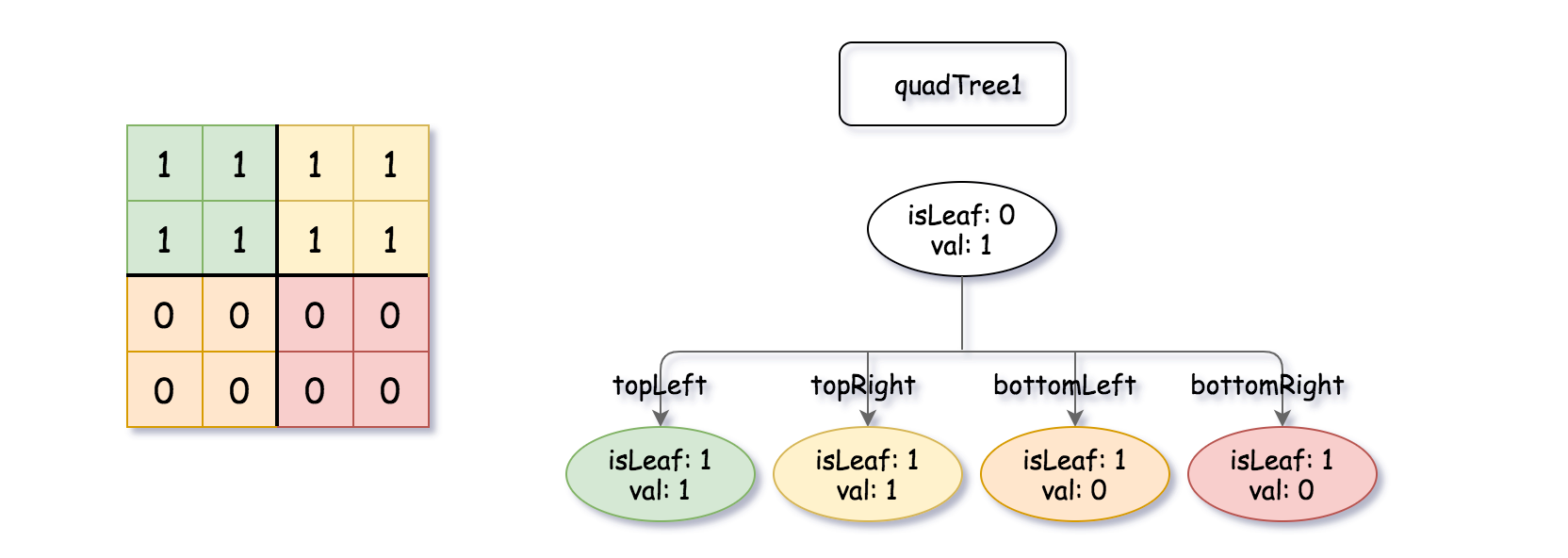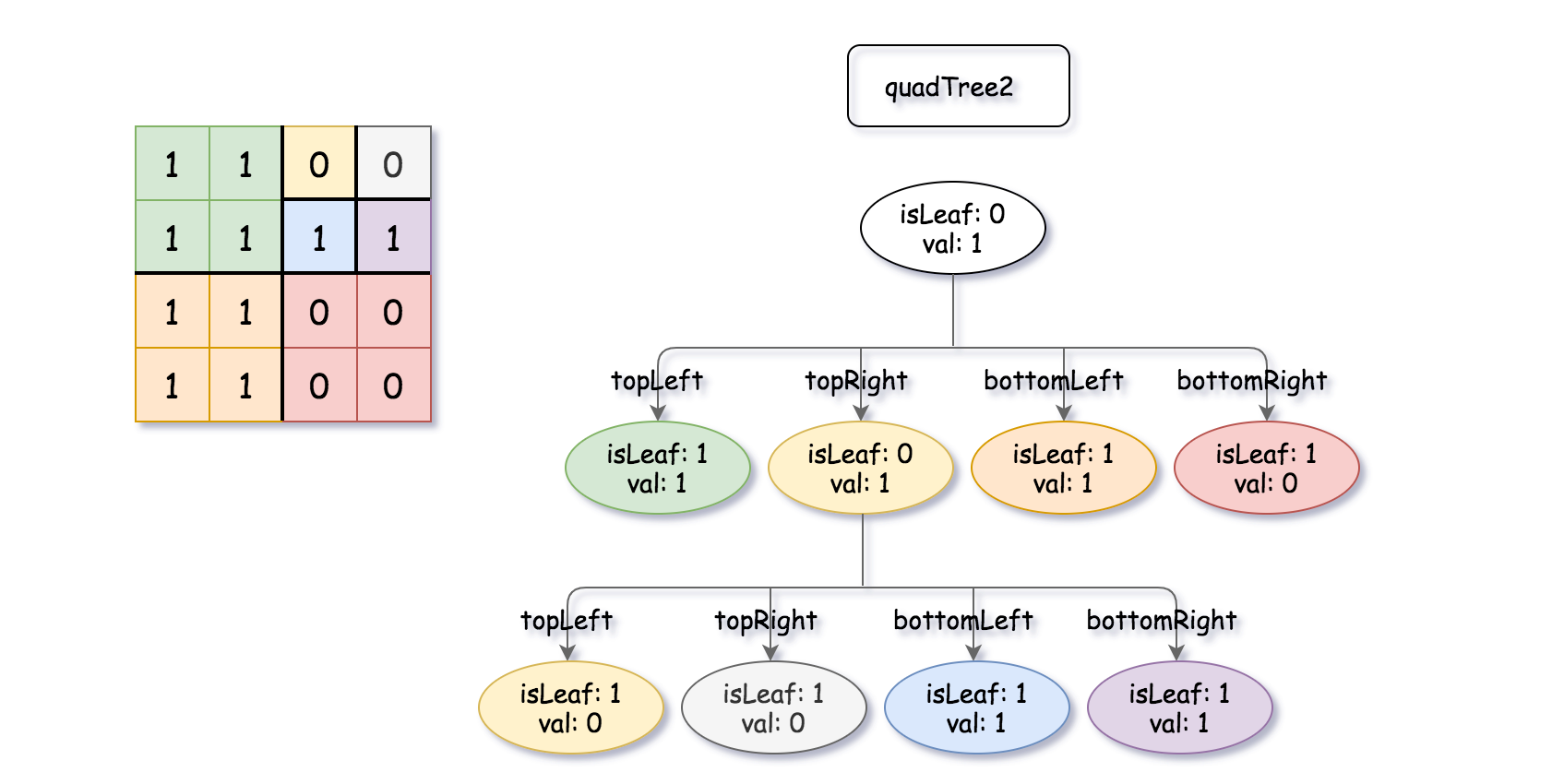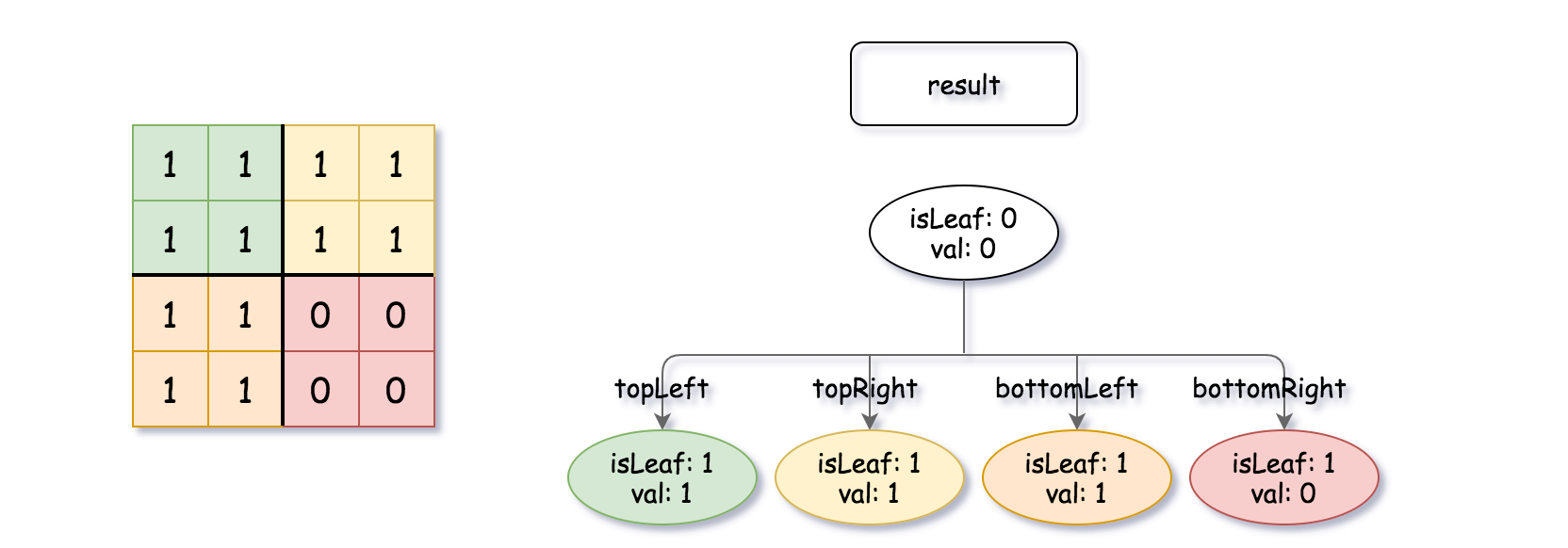| comments | difficulty | edit_url | tags | ||
|---|---|---|---|---|---|
true |
Medium |
|
A Binary Matrix is a matrix in which all the elements are either 0 or 1.
Given quadTree1 and quadTree2. quadTree1 represents a n * n binary matrix and quadTree2 represents another n * n binary matrix.
Return a Quad-Tree representing the n * n binary matrix which is the result of logical bitwise OR of the two binary matrixes represented by quadTree1 and quadTree2.
Notice that you can assign the value of a node to True or False when isLeaf is False, and both are accepted in the answer.
A Quad-Tree is a tree data structure in which each internal node has exactly four children. Besides, each node has two attributes:
val: True if the node represents a grid of 1's or False if the node represents a grid of 0's.isLeaf: True if the node is leaf node on the tree or False if the node has the four children.
class Node {
public boolean val;
public boolean isLeaf;
public Node topLeft;
public Node topRight;
public Node bottomLeft;
public Node bottomRight;
}
We can construct a Quad-Tree from a two-dimensional area using the following steps:
- If the current grid has the same value (i.e all
1'sor all0's) setisLeafTrue and setvalto the value of the grid and set the four children to Null and stop. - If the current grid has different values, set
isLeafto False and setvalto any value and divide the current grid into four sub-grids as shown in the photo. - Recurse for each of the children with the proper sub-grid.
If you want to know more about the Quad-Tree, you can refer to the wiki.
Quad-Tree format:
The input/output represents the serialized format of a Quad-Tree using level order traversal, where null signifies a path terminator where no node exists below.
It is very similar to the serialization of the binary tree. The only difference is that the node is represented as a list [isLeaf, val].
If the value of isLeaf or val is True we represent it as 1 in the list [isLeaf, val] and if the value of isLeaf or val is False we represent it as 0.
Example 1:
Input: quadTree1 = [[0,1],[1,1],[1,1],[1,0],[1,0]] , quadTree2 = [[0,1],[1,1],[0,1],[1,1],[1,0],null,null,null,null,[1,0],[1,0],[1,1],[1,1]] Output: [[0,0],[1,1],[1,1],[1,1],[1,0]] Explanation: quadTree1 and quadTree2 are shown above. You can see the binary matrix which is represented by each Quad-Tree. If we apply logical bitwise OR on the two binary matrices we get the binary matrix below which is represented by the result Quad-Tree. Notice that the binary matrices shown are only for illustration, you don't have to construct the binary matrix to get the result tree.
Example 2:
Input: quadTree1 = [[1,0]], quadTree2 = [[1,0]] Output: [[1,0]] Explanation: Each tree represents a binary matrix of size 1*1. Each matrix contains only zero. The resulting matrix is of size 1*1 with also zero.
Constraints:
quadTree1andquadTree2are both valid Quad-Trees each representing an * ngrid.n == 2xwhere0 <= x <= 9.
"""
# Definition for a QuadTree node.
class Node:
def __init__(self, val, isLeaf, topLeft, topRight, bottomLeft, bottomRight):
self.val = val
self.isLeaf = isLeaf
self.topLeft = topLeft
self.topRight = topRight
self.bottomLeft = bottomLeft
self.bottomRight = bottomRight
"""
class Solution:
def intersect(self, quadTree1: "Node", quadTree2: "Node") -> "Node":
def dfs(t1, t2):
if t1.isLeaf and t2.isLeaf:
return Node(t1.val or t2.val, True)
if t1.isLeaf:
return t1 if t1.val else t2
if t2.isLeaf:
return t2 if t2.val else t1
res = Node()
res.topLeft = dfs(t1.topLeft, t2.topLeft)
res.topRight = dfs(t1.topRight, t2.topRight)
res.bottomLeft = dfs(t1.bottomLeft, t2.bottomLeft)
res.bottomRight = dfs(t1.bottomRight, t2.bottomRight)
isLeaf = (
res.topLeft.isLeaf
and res.topRight.isLeaf
and res.bottomLeft.isLeaf
and res.bottomRight.isLeaf
)
sameVal = (
res.topLeft.val
== res.topRight.val
== res.bottomLeft.val
== res.bottomRight.val
)
if isLeaf and sameVal:
res = res.topLeft
return res
return dfs(quadTree1, quadTree2)/*
// Definition for a QuadTree node.
class Node {
public boolean val;
public boolean isLeaf;
public Node topLeft;
public Node topRight;
public Node bottomLeft;
public Node bottomRight;
public Node() {}
public Node(boolean _val,boolean _isLeaf,Node _topLeft,Node _topRight,Node _bottomLeft,Node
_bottomRight) { val = _val; isLeaf = _isLeaf; topLeft = _topLeft; topRight = _topRight; bottomLeft =
_bottomLeft; bottomRight = _bottomRight;
}
};
*/
class Solution {
public Node intersect(Node quadTree1, Node quadTree2) {
return dfs(quadTree1, quadTree2);
}
private Node dfs(Node t1, Node t2) {
if (t1.isLeaf && t2.isLeaf) {
return new Node(t1.val || t2.val, true);
}
if (t1.isLeaf) {
return t1.val ? t1 : t2;
}
if (t2.isLeaf) {
return t2.val ? t2 : t1;
}
Node res = new Node();
res.topLeft = dfs(t1.topLeft, t2.topLeft);
res.topRight = dfs(t1.topRight, t2.topRight);
res.bottomLeft = dfs(t1.bottomLeft, t2.bottomLeft);
res.bottomRight = dfs(t1.bottomRight, t2.bottomRight);
boolean isLeaf = res.topLeft.isLeaf && res.topRight.isLeaf && res.bottomLeft.isLeaf
&& res.bottomRight.isLeaf;
boolean sameVal = res.topLeft.val == res.topRight.val
&& res.topRight.val == res.bottomLeft.val && res.bottomLeft.val == res.bottomRight.val;
if (isLeaf && sameVal) {
res = res.topLeft;
}
return res;
}
}/*
// Definition for a QuadTree node.
class Node {
public:
bool val;
bool isLeaf;
Node* topLeft;
Node* topRight;
Node* bottomLeft;
Node* bottomRight;
Node() {
val = false;
isLeaf = false;
topLeft = NULL;
topRight = NULL;
bottomLeft = NULL;
bottomRight = NULL;
}
Node(bool _val, bool _isLeaf) {
val = _val;
isLeaf = _isLeaf;
topLeft = NULL;
topRight = NULL;
bottomLeft = NULL;
bottomRight = NULL;
}
Node(bool _val, bool _isLeaf, Node* _topLeft, Node* _topRight, Node* _bottomLeft, Node* _bottomRight) {
val = _val;
isLeaf = _isLeaf;
topLeft = _topLeft;
topRight = _topRight;
bottomLeft = _bottomLeft;
bottomRight = _bottomRight;
}
};
*/
class Solution {
public:
Node* intersect(Node* quadTree1, Node* quadTree2) {
return dfs(quadTree1, quadTree2);
}
Node* dfs(Node* t1, Node* t2) {
if (t1->isLeaf && t2->isLeaf) return new Node(t1->val || t2->val, true);
if (t1->isLeaf) return t1->val ? t1 : t2;
if (t2->isLeaf) return t2->val ? t2 : t1;
Node* res = new Node();
res->topLeft = dfs(t1->topLeft, t2->topLeft);
res->topRight = dfs(t1->topRight, t2->topRight);
res->bottomLeft = dfs(t1->bottomLeft, t2->bottomLeft);
res->bottomRight = dfs(t1->bottomRight, t2->bottomRight);
bool isLeaf = res->topLeft->isLeaf && res->topRight->isLeaf && res->bottomLeft->isLeaf && res->bottomRight->isLeaf;
bool sameVal = res->topLeft->val == res->topRight->val && res->topRight->val == res->bottomLeft->val && res->bottomLeft->val == res->bottomRight->val;
if (isLeaf && sameVal) res = res->topLeft;
return res;
}
};/**
* Definition for a QuadTree node.
* type Node struct {
* Val bool
* IsLeaf bool
* TopLeft *Node
* TopRight *Node
* BottomLeft *Node
* BottomRight *Node
* }
*/
func intersect(quadTree1 *Node, quadTree2 *Node) *Node {
var dfs func(*Node, *Node) *Node
dfs = func(t1, t2 *Node) *Node {
if t1.IsLeaf && t2.IsLeaf {
return &Node{Val: t1.Val || t2.Val, IsLeaf: true}
}
if t1.IsLeaf {
if t1.Val {
return t1
}
return t2
}
if t2.IsLeaf {
if t2.Val {
return t2
}
return t1
}
res := &Node{}
res.TopLeft = dfs(t1.TopLeft, t2.TopLeft)
res.TopRight = dfs(t1.TopRight, t2.TopRight)
res.BottomLeft = dfs(t1.BottomLeft, t2.BottomLeft)
res.BottomRight = dfs(t1.BottomRight, t2.BottomRight)
isLeaf := res.TopLeft.IsLeaf && res.TopRight.IsLeaf && res.BottomLeft.IsLeaf && res.BottomRight.IsLeaf
sameVal := res.TopLeft.Val == res.TopRight.Val && res.TopRight.Val == res.BottomLeft.Val && res.BottomLeft.Val == res.BottomRight.Val
if isLeaf && sameVal {
res = res.TopLeft
}
return res
}
return dfs(quadTree1, quadTree2)
}


